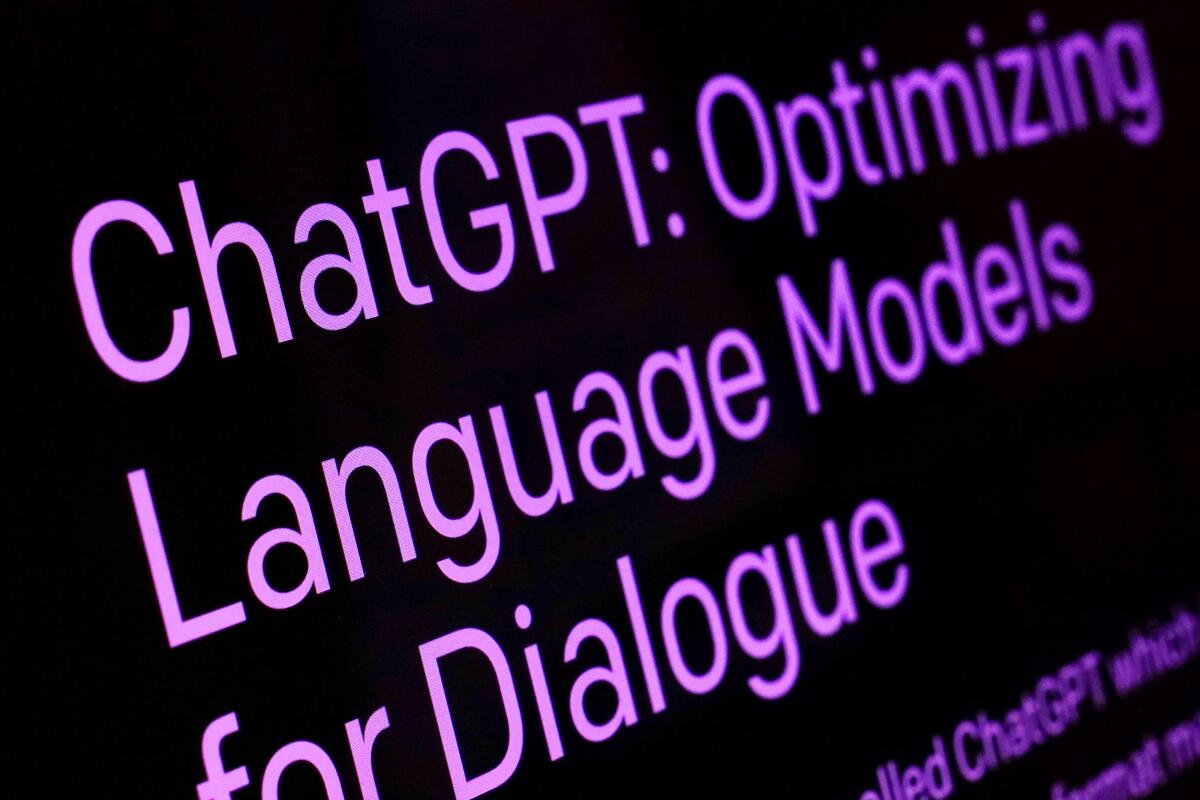Opinion: I’m co-teaching my college class with ChatGPT. Will it upstage me?

- Share via
Comedian Steve Martin once said that teaching is like show business. I try to keep this in mind when I’m giving college lectures.
But what happens when the entertaining professor gets upstaged by a chatbot that can produce the lecture as well as write student papers and take the final exam? Does the college class become a meaningless joke?
Well, no.
There are people who fear that ChatGPT, Bard and other generative AI bots will let students outsource their own learning. But I teach media history. I know that new media technologies do not make people obsolete. Video did not kill the radio star.
So rather than slip some language about ChatGPT in the policy section of my syllabus about plagiarism (which won’t stop students who know about the apps that can rewrite papers to evade detection), my plan this fall is to focus on creating interactive lessons that incorporate chatbots directly into my teaching.
Instead of letting chatbots change the learning process, I’ll show my students that anything that chatbots can do, they can do better.
Many of my students were already trying out ChatGPT last year. Because chatbots can be especially useful for performing routine tasks, one student explained that she had started to use ChatGPT at her job in customer service to generate quick responses to complaints, which she would then rewrite to improve.
While chatbots are able to do that kind of task well, more complicated tasks, such as historical essays, can be a disaster. But these limitations also open the door to teaching exercises that show students how to use this technology in their work.
Professors teaching writing skills can have chatbots generate outlines, drafts and other lists of ideas. Then, the professor can direct students to work in small groups to rewrite the text for greater originality.
Chatbots also offer an opportunity to teach critical thinking and media literacy skills. ChatGPT is prone to making up false information out of the data-driven cloud — a phenomenon its handlers euphemistically call “hallucinations.” This means that students have to learn how to check facts and verify information, using citable sources and databases.
How to spot the difference between an AI email and a human one.
Professors can also teach students to be alert to the systemic racism and sexism that AI bots can perpetuate and amplify because of the source texts they’re drawing from. I once asked ChatGPT to write a list of some of the leading scholars of the U.S. Constitution and the 1st Amendment. Its response included only white men — as if no person from another background, ethnicity or gender ever studied the U.S. Constitution.
A solution to this problem? Show students how they can give the chatbot follow-up prompts that generate more complete answers — say, specifically to include persons of color, different genders and diverse backgrounds. When I did this, ChatGPT readily listed Kimberlé Crenshaw, Ange-Marie Hancock and other prominent constitutional scholars.
For my classes this fall, I’m also creating “AI Moments,” where my students will get a chance to see who does it better: the robot or the professor.
After I present a new lesson and talk about it with my students, I’ll prompt ChatGPT to give a lecture on the very same subject.
To test out this idea over the summer, I asked ChatGPT to rewrite my short lecture on the history of broadcast media. Unsurprisingly, the text it generated was horrible. Just one cliché after another. The AI-generated draft also made bad word choices — replacing the word “media” with “platform” (not all media are platforms). It changed my question, “Did the emergence of broadcast TV mean the end of going to the movies?” and instead asked, “whether the emergence of broadcast TV resembled the demise of cinema attendance caused by the rise of radio.” This word choice altered the meaning of the point, which is that new media do not replace the old.
When I re-create this exercise in my classroom, I plan to have my students search ChatGPT’s lecture for bad writing that they will rewrite, turning each cliché into original imagery and poor word choices into something more precise. I’ll also ask them to find and eliminate bias and fact-check for inaccuracies.
What I learned from my practice matches with ChatGPT is that I know more about teaching journalism, writing and media history — even though the chatbot can draw from vast amounts of information on the internet. And more importantly, it cannot share ideas accurately or in a creative and engaging way.
I want my students to learn to use AI effectively, since these tools will become ever more common and maybe even indispensable in workplaces and in education. I think the best way to do that is to make this technology part of their classroom experience.
Elizabeth Blakey teaches media history at Cal State Northridge. This article was produced in partnership with Zócalo Public Square.
More to Read
A cure for the common opinion
Get thought-provoking perspectives with our weekly newsletter.
You may occasionally receive promotional content from the Los Angeles Times.











